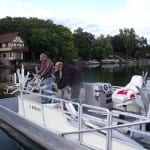ISU student Dan Taylor shows off two rainbow trout he caught near the dock at Ada Hayden Heritage Park Lake in Ames after the Iowa Department of Natural Resources stocked about 2,200 11- to 13-inch rainbow trout from a hatchery in Decorah, Iowa, on Friday November 19, 2011, in the north basin of the lake. / David Purdy/The Register
A whole stringer of folks are working to make sure Iowans can catch fish close to home.After all, the Iowa Department of Natural Resources figures, people are busy.
Gas prices are high. And if someone doesn’t get kids interested in fishing, and by extension, water quality, who will lead the push to clean up Iowa’s already troubled waterways in the coming decades?
The DNR has joined local and federal agencies and fishing clubs across the state to install new fish habitat in many lakes, some of which also are being stocked with keeper trout. Such urban fishing spots as Big Creek Lake, Easter Lake in Des Moines, Blue Heron Lake in West Des Moines and the pond at Des Moines Area Community College’s Ankeny campus are getting dredged, protected by siltation basins, or dotted with artificial reefs, for example.
See the dozens of unique artificial fish habitat models, fish attractors and fish cover used at fishiding.com, the leader in science based, proven, fish protection.
The state also is stocking trout in lakes near cities, and hybrid bass in gravel pits.
DNR surveys show most people fish within 20 miles of their homes, if they fish at all.
“We want kids to be able to walk or ride their bikes somewhere to fish,” said state fisheries biologist Ben Dodd.
Local fisherman Dave Merical of Ankeny has worked on many of the projects. “People don’t want to drive forever to fish,” said Merical, a leader in Central Iowa Anglers, a private group helping with the work. “We want people to have a good experience close to home. Kids are the future stewards of the resource. If they don’t enjoy fishing they aren’t going to want to take care of the waters.”
Joe Larscheid, who runs the state fisheries bureau, said fishing is one way to lure Iowans outdoors.
“It’s a nationwide epidemic,” Larscheid said. “It’s the Xbox generation. Kids are comfortable sitting in front of a computer and doing Facebook.” He’s working with health officials on a program called “Take It Outside” to encourage outdoor activities.
“Our initiative is to get people outside,” Larscheid said.
“Fishing is a gateway. When people are outside, they are more engaged with the environment and they are more likely to support conservation.”
There’s some ingenuity in the new initiative. Central Iowa Anglers and other groups are helping the cash- and staff-strapped DNR by providing materials that can be placed in lakes for fish habitat, giving catfish and other species somewhere to spawn.
So discarded pallets become makeshift underwater teepees, Merical said. Plastic pipe is formed into the shape of a tree. Cedar trees growing where they don’t belong are cut down, weighted down with cinder blocks, and dumped in the lakes to shelter fish. Barrels, too.
“The cost is insignificant because we use volunteer labor to do work the DNR approved and wanted done anyway, and the materials generally are donated,” Merical said.
The Des Moines area is getting the most attention in the early going, with work at Easter Lake , Blue Heron Lake, Lake Petoka in Bondurant and Big Creek and Saylorville near Polk City.
The U.S. Natural Resources Conservation Service and local soil and water conservation districts help by persuading farmers to conserve soil and carefully target chemicals they want kept out of waterways
One of the most popular parts of the program is the stocking of 10- to 12-inch rainbow trout in 16 lakes around the state.
The DNR announces when the 1,400 to 2,200 trout will be released in each spot, often drawing hundreds who hope to catch and eat the fish before anyone else does. The fish are raised at the Decorah hatchery.
It isn’t exactly shooting fish in a barrel, but the trout are very easy to catch, Larscheid said.
Usually, anglers catch all the released rainbow trout within two months, Larscheid said. It’s supposed to be easy. The idea is to get kids interested in fishing, and excite urban-dwellers about a sport that has produced flat license sales of about 300,000 a year.
Iowa has naturally reproducing brown and brook trout in some of the cold-water streams flowing through northeastern counties. But lakes contain only stocked trout. If they aren’t caught before temperatures rise, most of them die.
Ice fishing is big in Iowa, particular at places such as Clear Lake in north-central Iowa and the Iowa Great Lakes in Dickinson County in northwest Iowa. In the Des Moines area, biologists will release trout in both Lake Petoka and Ada Hayden Heritage Park Lake in Ames through the winter ice this season.
Iowans need a $12.50 trout stamp in addition to a fishing license to fish for trout. A resident fishing license costs $19. Children under age 16 can fish for trout without a license or stamp if they are with an adult who has both.
Dodd said the state also is experimenting with stocking hybrid striped bass, known as wipers, in gravel pits and ponds near cities.
They’ve been stocked at Saylorville Lake north of Des Moines for years, but have a reputation for being hard to catch.
They also don’t reproduce, and often get flushed through the spillway during floods. So it’s hard to keep the population up, Dodd said.
www.iowadnr.gov/Fishing/TroutFishing.aspx
